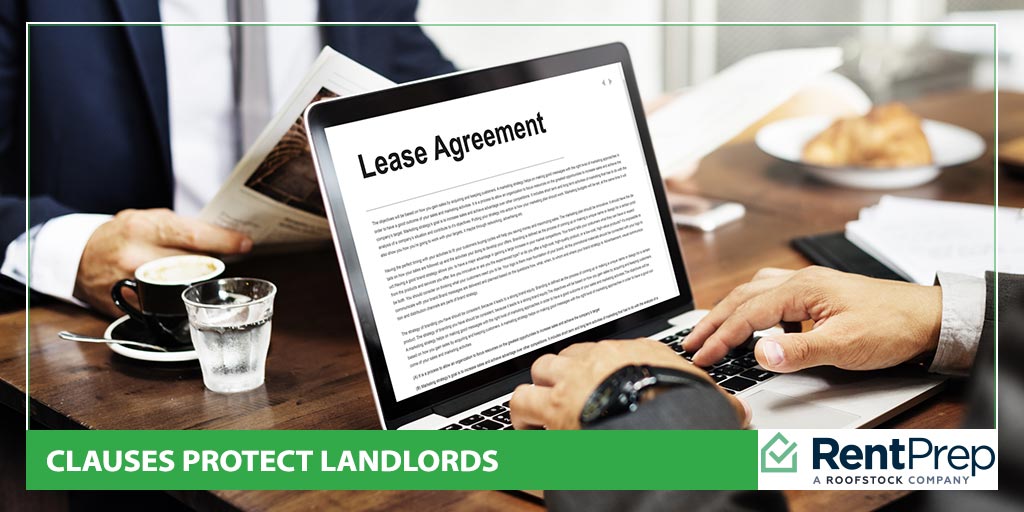
Embarking on the landlord journey can be exhilarating, but the lease agreement—your legal safety net—can become a source of headaches if not wielded wisely.
Ideally, the lease protects your rental property and your investment, along with the rights of the tenant to use that property. Getting the lease agreement right is important because if issues do arise, the lease provides the basis for resolution.
Many standard lease agreements are available, but what exactly you include in your own lease depends on the type of rental property you have and the laws where your rental is located.
When preparing your final lease agreement, there are several important clauses to double-check, as these protect your interest in the property and protect you against excessive liability.
Below, we’ll cover ten essential lease agreement clauses to protect landlords. You can use our guide as a checklist when reviewing your next rental agreement. However, this should not be considered legal counsel, and always consult a qualified lawyer if you have any doubts about what to include in your lease.
Table Of Contents: Essential Lease Agreement Clauses
Discover essential lease agreement clauses that protect landlord interests.
- 1 – Severability Clause
- 2 – Use Of The Property Clause
- 3 – Rent Payments And Late Fees
- 4 – Renewal Clause
- 5 – Security Deposit Clause
- 6 – Early Termination Clause
- 7 – Right To Entry Clause
- 8 – Joint And Several Liability Clause
- 9 – Subletting Clause
- 10 – Surrender Of Premise Clause
- Bonus: Indemnification Of Landlord Clause
- FAQs
- Protect Yourself With A Good Lease Agreement
1 – Severability Clause

Laws do change, of course, and mistakes happen, which means you could find yourself with a section in your lease considered inapplicable under the law. If that happens, you don’t want the rest of your lease to become null and void, leaving you with a tenant with no lease agreement.
A severability clause states that if any portion of the lease is found to be inapplicable, the rest of the lease remains valid. The clause can be simple, stating that if any provision in the lease is invalid, the remaining terms and conditions shall not be impaired in any way.
2 – Use Of The Property Clause
When you sign a lease with a tenant, you aren’t giving them blanket permission to use the property for everything and anything but, rather, for a specific purpose–for example, as a residential living space for the individuals listed on the lease.
This arrangement should be spelled out in the lease, making it clear the tenant can’t use the property for certain activities, such as running a business, providing storage facilities, or subletting as a short-term vacation rental.
Not only does this make tenants aware of what they can and cannot do on the property, but if you do find they’re engaging in any type of banned activity, you could pursue eviction or other legal action on the firm grounds that they have broken the conditions of the lease.
3 – Rent Payments And Late Fees Clause
It’s fundamental that your lease agreement includes how much the tenant must pay you for the use of the property, including the rent and security deposit. The lease should also be clear on the monthly due date and the consequences of missing that date.
If you decide to make the rent due on the last day of every month, most states have a mandatory grace period that you must grant tenants before they start incurring late fees. For example, in New York City, it’s five days. The city also caps that fee at $50 or 5% of the monthly rent, whichever is lower.
You should include the grace period and late fees that you intend to apply in your lease agreement so tenants know the consequences of missing payments. At the same time, what you include in the lease must be in accordance with local laws.
4 – Renewal Clause
Tenants and landlords often decide to renew leases when the original lease term is over. It’s a good idea to include rules about the process in the lease so you aren’t left wondering whether the tenant intends to renew or if you need to start looking for a new tenant.
You can specify that the tenant has a specific period to let you know whether they intend to renew or not—for example, 30 to 60 days. If they don’t let you know within that time frame, you can assume they will move out and proceed accordingly.
You also can set the lease to automatically renew unless the tenant specifically states their intention to vacate. This is more common with month-to-month leases.
It’s good practice to let the tenant know how much notice you will give them if you decide not to renew the lease, perhaps because you intend to use the property for a different purpose. This should be comparable to the notice they need to give you so tenants have time to find a new home if necessary.
5 – Security Deposit Clause

The amount the tenant will pay for the security deposit should be included in the lease, along with the stipulation that they cannot move in until the security deposit is paid.
Landlords also have a responsibility to manage security deposits fairly, so the lease should inform the tenant where and how the security deposit will be held.
The lease should include information on how the security deposit can be spent—for example, to fix damage or pay for excessive cleaning, if required. Remember that you cannot use the security deposit to manage general wear and tear, so if you include this in your lease agreement, it will not be legally binding.
Another provision to include is whether the deposit can be used to cover the last month’s rent. While many landlords allow this for convenience, it’s not always a good idea. If the tenant moves out without paying the last month’s rent, assuming it’s covered by the security deposit, and then the landlord discovers damages, they must pursue the tenant for more money to cover the cost.
6 – Early Termination Clause
There are many reasons why either you or the tenant may wish to end the lease early. Perhaps they got a new job and need to move to a new city. Since they have signed the lease, the tenant is technically still liable for that rental agreement until its end, but you can include instructions on how they can terminate the lease early if necessary.
This should include how they should let you know and how the outstanding rent will be resolved. You can leave it up to the tenant to find a sublet or make them responsible for the rent until you can find a qualified new tenant, which you are obliged to do promptly.
This early termination clause protects you from lost rental income and helps the tenant understand the right way to break a lease if it becomes necessary.
7 – Right To Entry Clause
When you sign a lease agreement with a tenant, you’re giving them the right to fair use of the property, which then limits your right to enter. With the exception of specific emergencies, such as a fire or gas leak, you must give the tenants at least 24 hours notice before entering the property, including for inspections or repairs.
In some states, you need to give longer notice–for example, 48 hours–for an end-of-lease inspection or to show the property to potential new tenants.
While what you can do is dictated by law, it’s a good idea to make this clear in the lease as well, so tenants know how you will contact them and how much notice you’ll give. You can also state what constitutes an emergency and how long it might take you to visit if they call you.
Bear in mind that if you include elements in this clause that break the law, such as a reduced notice period, this part of the lease agreement will become inapplicable.
8 – Joint And Several Liability Clause
If you have multiple tenants in your property, you may not be particularly interested in how they divide the rent between them, as long as it’s paid. But conflicts between tenants about who should pay the rent can result in late payments that leave you out of pocket.
A liability clause states that the tenants collectively are responsible for full payment of the rent and not simply for a portion of the rent. Therefore, if one of the roommates refuses to pay their portion for any reason, the other tenants are still responsible for ensuring that the full rent is paid on time.
This liability would also extend to damages. If one roommate causes damage to the property and then disappears, the remaining roommates would still be liable to pay for the damages under this lease clause.
9 – Subletting Clause
It’s up to you whether you allow your tenants to sublet, whether that be subletting a room to an unnamed tenant, subletting the entire property if the original tenant decides to move out early, or subletting intermittently through vacation rental services.
You can prohibit your tenants from subletting without formal approval, for example, to add a roommate or if they intend to move out early. Or you can grant tenants the freedom to sublet based on certain terms and conditions. You can also add requirements such as an additional security deposit for subletters.
As a landlord, you can also include a clause in the rental contract that states the tenant who holds the lease is responsible for any damage that might be caused by their subletters.
10 – Surrender Of Premise Clause
While the general expectation is that tenants will return a property to the landlord in the same condition in which they received it, except for standard wear and tear, this can be hard to enforce without a surrender of premise clause. This clause states the condition the property should be in when vacated.
The lease should specify that the tenants must remove all personal items, dispose of all garbage, thoroughly clean the inside of the property, and leave outside and common areas in a reasonably clean state.
If these requirements aren’t clearly spelled out, it could be challenging to legally deduct from the security deposit charges such as waste disposal and removal of personal property that does not belong to the landlord.
Bonus: Indemnification Of Landlord Clause
The lease should include a clause that the tenant cannot hold the landlord responsible for the loss or damage of property or the injury of any person on the premises. The landlord cannot be held responsible for things that happen on the property that are beyond their control.
However, this clause will not extend to any issues resulting from the property not being maintained in a safe and habitable condition. For example, if an accident resulted from an existing structural integrity problem that the landlord has ignored, the landlord can still be liable.
Lease Clause FAQs
Below are answers to some of the most frequently asked landlord questions about lease agreements.
How can landlords ensure their lease agreements comply with local laws?
Landlords should research local and state housing laws to ensure their lease agreements are compliant. This may involve consulting legal resources, hiring a real estate lawyer, or using updated templates from a reputable property management company.
Can landlords change the terms of a lease agreement after it has been signed?
Generally, the terms of a lease agreement cannot be changed unless both parties agree to the modifications in writing. Any changes should be documented as amendments to the original lease and signed by both the landlord and tenant.
What should landlords do if tenants violate a clause in the lease agreement?
Landlords should follow the procedures outlined in the lease agreement for dealing with violations. This typically involves providing written notice to the tenant detailing the violation and offering a chance to remedy the situation within a specified time frame. If the issue is unresolved, landlords may need to pursue legal eviction, adhering to local laws and regulations.
Protect Yourself With A Good Lease Agreement
If you create an entirely one-sided lease agreement that compromises a tenant’s legal rights, the lease will not be considered legally binding if you face problems later on.
However, ensuring that a few important allowable clauses are included in the rental agreement can go a long way to protecting your interests as a landlord.
Note: RentPrep does not provide tax, legal or accounting advice. This material has been prepared for informational purposes only and is not intended to provide, and should not be relied on for, tax, legal, or accounting advice. You should consult your own tax, legal, or accounting advisors.

